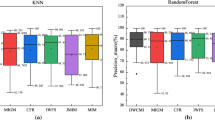Abstract
In order to further a classifier construction, feature selection algorithms reduce the input dimensionality to a subset of the most informative features. Usually, such subset is fixed and chosen on the preprocessing step before the actual classification. However, when it is difficult to find a small number of features sufficient for classification of all data samples, as in cases of the heterogeneous input data, we suggest an adaptive approach assuming selection of different features for every testing sample. The adaptive sequential algorithm proposed here selects features that for a given testing sample maximize the expected reduction of uncertainty about its class, where the uncertainty is updated with the values of the already selected features observed on this testing sample. The provided experiments show that especially in cases of limited amount of training data our adaptive conditional mutual information feature selector outperforms two the most related information-based static and adaptive algorithms.
Access this chapter
Tax calculation will be finalised at checkout
Purchases are for personal use only
Preview
Unable to display preview. Download preview PDF.
Similar content being viewed by others
References
Webb, A.: Statisctical Pattern Recognition, pp. 213–226. Arnold, London (1999)
Narendra, P., Fukunaga, K.: A branch and bound algorithm for feature subset selection. IEEE Transactions on Computers 28(2), 917–922 (1977)
Ding, C.H.Q., Peng, H.: Minimum redundancy feature selection from microarray gene expression data. Journal of Bioinformatics and Computational Biology 3(2), 185–206 (2005)
Abe, S.: Modified backward feature selection by cross validation. In: Proc. of the Thirteenth European Symposium on Artificial Neural Networks, Bruges, Belgium, pp. 163–168 (2005)
Duch, W., Wieczorek, T., Biesiada, J., Blachnik, M.: Comparison of feature ranking methods based on information entropy. In: Proc. of the IEEE International Joint Conference on Neural Networks, Budapest, Hungary, pp. 1415–1419 (2004)
Battiti, R.: Using mutual information for selecting feature in supervised neural net learning. IEEE Transactions on Neural Networks 5(4), 537–550 (1994)
Bonnlander, B.V., Weigend, A.S.: Selecting input variables using mutual information and nonparametric density estimation. In: International Symposium on Artificial Neural Networks, Taiwan, pp. 42–50 (1994)
Kwak, N., Choi, C.: Input feature selection by mutual information based on parzen window. IEEE Transactions on Pattern Analysis and Machine Intelligence 24, 1667–1671 (2002)
Bonnlander, B.V.: Nonparametric selection of input variables for connectionist learning. PhD thesis, University of Colorado at Boulder (1996)
Raudys, S.J., Jain, A.K.: Small sample size effects in statistical pattern recognition: Recommendations for practitioners. IEEE Transactions on Pattern Analysis and Machine Intelligence 13, 252–264 (1991)
Jiang, H.: Adaptive feature selection in pattern recognition and ultra-wideband radar signal analysis. PhD thesis, California Institute of Technology (2008)
Renninger, L.W., Verghese, P., Coughlan, J.: Where to look next? Eye movements reduce local uncertainty. Journal of Vision 7(3), 1–17 (2007)
Najemnik, J., Geisler, W.S.: Optimal eye movement strategies in visual search. Nature 434, 387–391 (2005)
Geman, D., Jedynak, B.: An active testing model for tracking roads in satellite images. IEEE Transactions on Pattern Analysis and Machine Intelligence 18(1), 1–14 (1996)
Cover, T.M., Thomas, J.A.: Elements of information theory, pp. 12–49. Wiley Interscience, Hoboken (1991)
Brown, G., Pocock, A., Zhao, M.J., Luján, M.: Conditional likelihood maximisation: A unifying framework for information theoretic feature selection. Journal of Machine Learning Research 13, 27–66 (2012)
Rosenblatt, M.: Remarks on some nonparametric estimates of a density function. Annals of Mathematical Statistics 27, 832–837 (1956)
Parzen, E.: On estimation of a probability density and mode. Annals of Mathematical Statistics 35, 1065–1076 (1962)
Turlach, B.A.: Bandwidth selection in kernel density estimation: a review. In: CORE and Institut de Statistique, pp. 23–493 (1993)
Silverman, B.W.: Density estimation for statistics and data analysis. Chapman and Hall (1986)
Zhang, X., King, M.L., Hyndman, R.J.: Bandwidth selection for multivariate kernel density estimation using MCMC. Technical report, Monash University (2004)
Scott, D.W.: Multivariate Density Estimation: Theory, Practice, and Visualization, pp. 125–206. John Wiley (1992)
Johnson, W.E.: Probability: deductive and inductive problems. Mind 41, 421–423 (1932)
Hubel, D., Wiesel, T.: Brain and visual perception: the story of a 25-year collaboration, p. 106. Oxford University Press US (2005)
LeCun, J., Cortes, C.: The mnist dataset of handwritten digits, http://yann.lecun.com/exdb/mnist/ (n.d.) (retrieved)
Bergstra, J., Breuleux, O., Bastien, F., Lamblin, P., Pascanu, R., Desjardins, G., Turian, J., Warde-Farley, D., Bengio, Y.: Deep learning tutorials, http://deeplearning.net/tutorial/lenet.html (n.d.) (retrieved)
LeCun, Y., Bottou, L., Bengio, Y., Haffner, P.: Gradient-based learning applied to document recognition. Proc. of the IEEE 86(11), 2278–2324 (1998)
Author information
Authors and Affiliations
Corresponding author
Editor information
Editors and Affiliations
Rights and permissions
Copyright information
© 2015 Springer International Publishing Switzerland
About this paper
Cite this paper
Avdiyenko, L., Bertschinger, N., Jost, J. (2015). Adaptive Information-Theoretical Feature Selection for Pattern Classification. In: Madani, K., Correia, A., Rosa, A., Filipe, J. (eds) Computational Intelligence. IJCCI 2012. Studies in Computational Intelligence, vol 577. Springer, Cham. https://doi.org/10.1007/978-3-319-11271-8_18
Download citation
DOI: https://doi.org/10.1007/978-3-319-11271-8_18
Publisher Name: Springer, Cham
Print ISBN: 978-3-319-11270-1
Online ISBN: 978-3-319-11271-8
eBook Packages: EngineeringEngineering (R0)




